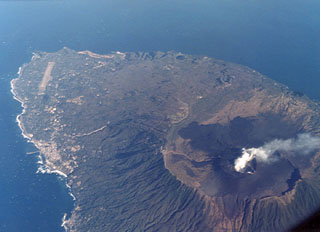Report on Izu-Oshima (Japan) — August 1988
Scientific Event Alert Network Bulletin, vol. 13, no. 8 (August 1988)
Managing Editor: Lindsay McClelland.
Izu-Oshima (Japan) Strong seismicity prompts volcanic activity warning
Please cite this report as:
Global Volcanism Program, 1988. Report on Izu-Oshima (Japan) (McClelland, L., ed.). Scientific Event Alert Network Bulletin, 13:8. Smithsonian Institution. https://doi.org/10.5479/si.GVP.SEAN198808-284010
Izu-Oshima
Japan
34.724°N, 139.394°E; summit elev. 746 m
All times are local (unless otherwise noted)
From late July to mid-August, numerous events clustering 10-20 km NW of Izu-Oshima Island . . . were detected at JMA's Oshima Weather Station, where 240 events were felt (figure 16a). Low-amplitude tremor was continuous. Episodes of larger amplitude tremor were superimposed at 1-hour intervals. On 21 August, the volcano emitted a white plume, its highest (1,900 m) since explosions resumed in November 1987. High levels of summit crater seismicity were recorded 19-23 August and 31 August-7 September, the last day of the report period (figure 16b). On 1 September, 423 events were recorded, the largest daily total since 3 March (502 events). The vigorous seismicity prompted the Oshima Weather Station to issue a volcanic activity warning.
 |
Figure 16. Daily number of earthquakes centered (a) at Oshima volcano and (b) E of the Izu Peninsula. Courtesy of JMA. |
Geological Summary. Izu-Oshima volcano in Sagami Bay, east of the Izu Peninsula, is the northernmost of the Izu Islands. The broad, low stratovolcano forms an 11 x 13 km island constructed over the remnants of three older dissected stratovolcanoes. It is capped by a 4-km-wide caldera with a central cone, Miharayama, that has been the site of numerous recorded eruptions datining back to the 7th century CE. More than 40 cones are located within the caldera and along two parallel rift zones trending NNW-SSE. Although it is a dominantly basaltic volcano, strong explosive activity has occurred at intervals of 100-150 years throughout the past few thousand years. A major eruption in 1986 produced spectacular lava fountains up to 1,600 m high and a 16-km-high eruption column; more than 12,000 people were evacuated from the island.
Information Contacts: JMA.

